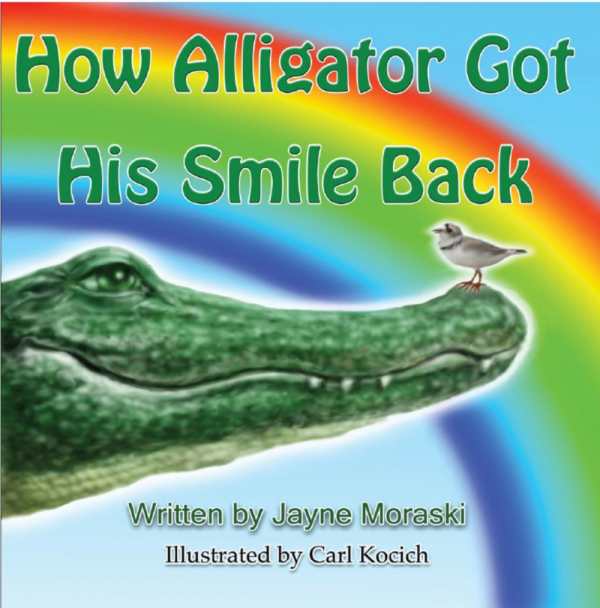
How Alligator Got His Smile Back
Clever, vivid storytelling helps convey a message of self-acceptance and humility.
Author Jayne Moraski and illustrator Carl Kocich join forces for a picture-book folktale in the tradition of Rudyard Kipling. How Alligator Got His Smile Back is a journey into friendship and self-confidence with a science lesson along the way, designed especially for children ages four to eight.
Moraski’s tale begins in the prehistoric era as Alligator and Tadpole Frog play in the swampy marsh. Alligator extends kindness to his friend. But Frog gets prideful, especially when he discovers an ability Alligator doesn’t have—Frog can hop onto land. He taunts his long-nosed friend and others, eventually hurting Alligator’s feelings. Alligator’s frown inspires his friends to ask the Great Spirit for help. Alligator is granted legs, so he, too, can travel onto land. There’s just one condition with this gift: he may not brag. So when he sees his boastful friend again, the question is, how will he respond?
Moraski presents a sweet story with a strong lesson. Most kids face issues of self-esteem when they discover that others have abilities they don’t. Many also know someone, perhaps a friend or classmate, who brags or otherwise says hurtful things. Kids will readily identify with such situations, and the book provides practical examples of how to address them. The characters are as enjoyable as they are relatable. In fact, it’s refreshing that the alligator is the kind one and the frog plays the antagonist. It’s a small lesson on assumptions about others.
The storytelling is clever, and the writing is often vivid: “He cried and cried, turning the freshwater swamp salty with his flood of tears.” The “Just So” portion of the story (folklore explaining why the world is as it is) is equally capable: “The winds swept his salty tears away from the marsh and out to sea.” However, some vocabulary and concepts could challenge younger readers (freshwater, briny, and basking, for example).
The book suggests potential educational use, with explanations of habitats and species provided in the back. However, some learning activities, such as a Venn diagram, will not be appropriate for the youngest readers. And mixing folklore with true science may prove problematic for some. Metamorphosis and evolution jumble together a bit, for example, but a strong teacher may be able to sort that out.
Kocich’s captivating pastel illustrations are rich and beautiful. The frames around them are clever, reflecting elements of the main illustrations, but their primitive style jars against the soft wonder of the main pictures.
A savvy educator might find How Alligator Got His Smile Back helpful in a classroom, and parents might enjoy sharing it with a child as a standard folktale.
Reviewed by
Diane Gardner
Disclosure: This article is not an endorsement, but a review. The publisher of this book provided free copies of the book and paid a small fee to have their book reviewed by a professional reviewer. Foreword Reviews and Clarion Reviews make no guarantee that the publisher will receive a positive review. Foreword Magazine, Inc. is disclosing this in accordance with the Federal Trade Commission’s 16 CFR, Part 255.
